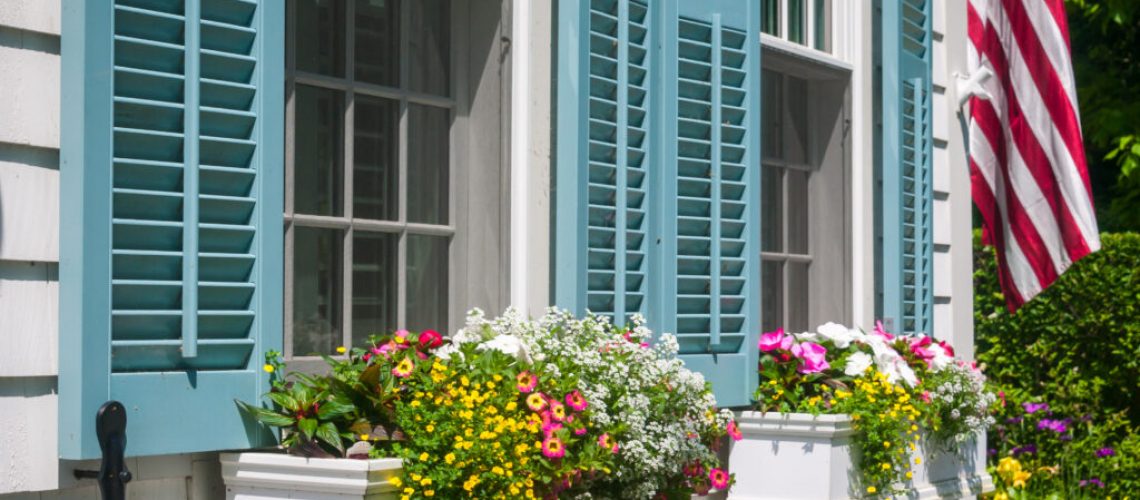American homes have been shaped by various historical eras, each leaving a distinct mark on their architectural styles and interior design. From the refined elegance of Neoclassicism to the luxury of the Victorian Era, the functional simplicity of the Mid-20th Century boom, and the multicultural influences brought by immigrants, these historical periods have had a lasting impact on the homes we live in today. This Independence Day, let’s explore how each era has influenced modern American homes and contributed to the diverse and rich melting pot of American home design today.
Neoclassicism (1780-1860)
The Neoclassicism era emerged in the aftermath of the American Revolution, drawing inspiration from classical Greek and Roman architecture. Symmetry, neutral tones, and clean lines defined the neoclassical design style. American homes began to incorporate features like symmetrical exteriors, columns, and crown moldings, reflecting a sense of elegance and order that aligned with the ideals of the young United States. Even today, neoclassical elements continue to grace modern American homes, adding a touch of timeless sophistication.
This home we remodeled in Clearwater had several Neoclassical influences, including the moldings, baseboard and windows.
Victorian Era (Mid-19th to Early 20th Century)
The Victorian Era, known for its elaborate and ornate designs, brought a shift from simplicity to luxury in American homes. Victorian houses used intricate woodwork and vibrant wallpapers. The emphasis was on displaying wealth and status. Today, we can still witness the influence of the Victorian Era in many American homes. The use of bay windows, decorative trim, and patterned wallpapers inspires the nostalgic charm of this era.
This home we remodeled in Harbor Oaks contains a number of Victorian features, such as white trellis garden gates, arbors, and red brick.
The Gilded Age (1880-1929)
During the Gilded Age, rapid economic growth and wealth expansion shaped American homes. Extravagant mansions with ornate exteriors, intricate detailing, and luxurious materials like marble and stained glass became the norm. Modern American homes continue to be influenced by the Gilded Age, as elements such as high ceilings, elaborate moldings, and elegant chandeliers capture the richness and magnificence of this period. The architectural and interior design legacy of the Gilded Age still inspires those seeking to recreate a sense of luxury and elegance in their homes.
This home we remodeled in Oldsmar contains a number of elements that could have been influenced by the Gilded Age, such as marble countertops, glass tile backsplash, elegant chandeliers, and elaborate woodwork like the coffered ceilings and crown molding.
Mid-20th Century Boom (1940s-1960s)
The post-World War II period brought rapid economic growth and cultural change in the United States. This era witnessed the rise of modern design and a focus on convenience. Open floor plans, large windows, and seamless indoor-outdoor connections became popular architectural styles, particularly in the form of Mid-Century Modern homes. Today, modern American homes continue to draw inspiration from the clean lines, functionality, and simplicity of the Mid-20th Century Boom.
This condo we remodeled on Sand Key Beach was done in a modern style, with its open floor plan, clean lines, and sleek simplicity.
Immigrant Influences: A Cultural Melting Pot
Immigrants throughout American history have brought their cultural traditions, architectural styles, and design sensibilities, enriching American homes. From European settlers to diverse immigrant groups in the 19th and 20th centuries, each wave of immigrants contributed to the unique melting pot of home design. Architectural designs such as Victorian, Southwest, and New York City townhouses bear the imprint of immigrant influences. The aesthetic of modern American homes is also shaped by immigrant cultures, introducing fresh patterns, colors, and decorative accents that celebrate the diverse heritage of American society.
This home addition and whole home remodel we did in Brandon, Florida included a number of Spanish influences, especially on the façade. The designer we hired for this project was originally from Mexico, and she brought a Spanish flair to the design that the client fell in love with.
Conclusion
As we celebrate Independence Day, we can’t help but acknowledge the profound influence that historical periods and diverse cultural influences have had on shaping the architectural styles and interior design trends of modern American homes. Neoclassicism, the Victorian Era, the Gilded Age, the Mid-20th Century Boom, and the multicultural influences brought by immigrants have all had a significant impact on the architectural styles and interior design trends of modern American homes. With a wide variety of options that reflect the rich variety of American history and culture, these influences continue to shape how we design and live in our homes today. Today, we are fortunate to have a wide range of design options that represent the vibrant melting pot of American history and culture. Our homes reflect the diverse heritage of our nation.
May our homes serve as a testament to the spirit of freedom, invention, and cultural exchange that defines the American experience.
Happy Independence Day!
Nelson Construction and Renovations, a family business founded in 2006, is a design-build company that specializes in high-end remodels, home additions, and custom homes. With our headquarters in Clearwater, Florida, we serve homeowners all over Pinellas and Hillsborough Counties. We are an award-winning member of the National Association of the Remodeling Industry and have an A+ rating with the Better Business Bureau.
Creative Commons Attribution: Permission is granted to re-post this article in its entirety with credit to Nelson Construction and a clickable link back to this page.
